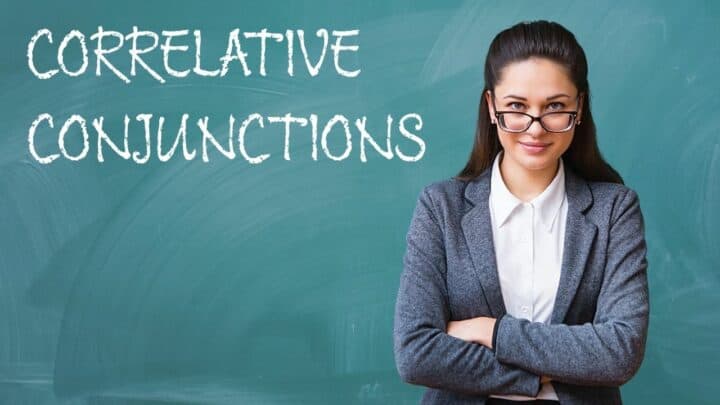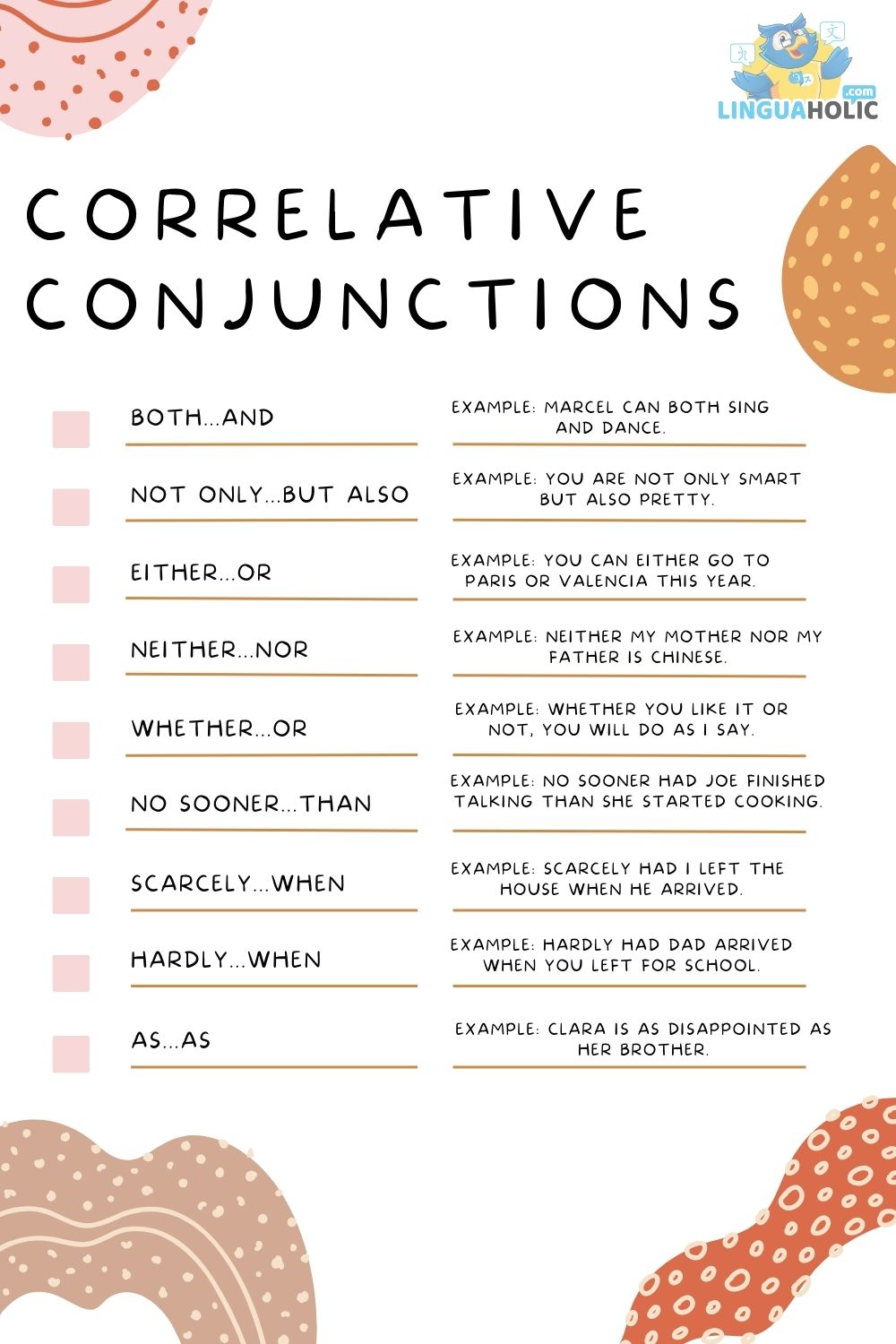There are three main types of conjunctions: Coordinating conjunctions, subordinating conjunctions and correlative conjunctions.
In this article, we will tackle correlative conjunctions.
Let’s roll our ball by starting with the usual quick answer.
What are correlative conjunctions?
Correlative conjunctions are the conjunctions that come in pairs and are inseparable. They are very useful in blending ideas that are equally important in terms of grammar and meaning. Examples of these include “not only…but also,” “either…or,” “whether…or,” “no sooner…than,” and “as…as.”
Correlative conjunctions: The “inseparables”
Correlative conjunctions are inseparable words because one cannot stand alone without the other. Doing so does not achieve the same effect anymore.
That is, a pair of correlative conjunction strictly works together in order to convey our thoughts precisely as well as in a parallel way.
These types of conjunctions connect two sentence parts that are of equal value or importance, both in sense and grammar.
Like coordinating conjunctions and subordinating conjunctions, correlative conjunctions also have different functions in language use.
To recall, coordinating conjunctions connect two independent clauses, while subordinating conjunctions link an independent clause to a dependent clause.
If you are wondering what exactly “clauses” stand for in grammar, you may read our guide that distinguishes clauses and phrases for clarity.
Meanwhile, correlative conjunctions can do way more than just connect clauses together. In fact, they can actually “blend” them.
We mainly use correlative conjunctions to add one idea after another, express alternatives, convey conditions, show the order of events, and even introduce comparisons.
To understand how correlative conjunctions work in context, let us discuss each of them one by one according to function.
Correlative conjunctions for adding ideas
Additive correlative conjunctions work together solely for the purpose of adding more value to whatever idea we are trying to express.
“Both…and” and “not only…but also” are two of the most commonly used additive correlative conjunctions in English.
Using either of them is great for increasing the implied importance of two equally meaningful ideas in one smooth flow.
Both…and
The word “both” suggests the meaning “one plus another one,” while “and” may suggest the meaning “together with” or “besides.”
A comma comes before “and” when it is used as a coordinating conjunction. However, this comma disappears when “and” is used as a correlative conjunction.
That said, the combined meaning of “both…and” utterly becomes more powerful than using either word as single elements.
Examples:
In both of the examples above, each of the subjects is followed by compound ideas in the predicate part.
Interestingly, we may also create compound subjects using the pair “both…and” if we want to, such as in “both Mary and Michelle.”
Not only…but also
The pair “not only…but also” is another great correlative conjunction to use for adding an important idea after another.
“Not only” suggests the meaning “not just,” which is good for emphasizing the truth value of an idea. Meanwhile, “but also” is responsible for making this truth value even more promising.
Remember that as a stand-alone word, a comma before “not” is mainly used for inserting interruptive thoughts within the sentence.
However, a comma before “but” is always used when it is used as a coordinating conjunction in a compound sentence.
When connecting incomplete clauses and phrases, the pair “not only…but also” does not need any comma placement at all.
Examples:
As you can see, the first example makes use of a compound predicate, while the second example makes use of a compound subject.
Doing so is simply possible with correlative conjunctions. This reduces redundant statements, which then makes our sentences cleaner and more attractive.
Correlative conjunctions for alternative ideas
In simple terms, alternative ideas are options or choices. When we present such kinds of ideas through language, we can seek help from correlative conjunctions.
The most common correlative conjunctions used for expressing alternative ideas are “either…or” and “neither…nor.”
While “either…or” is used in the affirmative sense, “neither…nor” is used in the negative sense. Luckily enough, this distinction is pretty easy to remember.
Either…or
When presenting two alternatives or options, we can use the pair “either…or.” Doing so allows us or our listeners to pick a choice on what to do or believe.
Placing a comma before or after “either” alone is a tricky thing to do. This is because “either” wears many different hats.
What we have to remember, though, is never to use any commas immediately around “either” when it is paired with “or” in a sentence.
But then again, you would likely need a comma before “or” when it is separately used as a coordinating conjunction, just like “but.”
Examples:
In the examples above, the use of “either…or” allows us to express optional ideas effectively. This meanwhile makes our statements more of a two-way than a one-way street.
Neither…nor
On the other end of the spectrum is “neither…nor.” This pair is great for expressing negation of ideas at the cost of just a few words.
As a single entity, “nor” is a coordinating conjunction. Therefore, a comma before “nor” usually comes when it connects two independent clauses.
However, no comma should be used when “neither” and “nor” are deliberately used as a correlative pair of conjunction.
Examples:
Taking things into perspective, “neither…nor” is great for making sure that similarly negative ideas are not repeatedly stated in two separate sentences.
Correlative conjunctions for conditional ideas
Sometimes, we also need to present conditions. In grammar, conditional statements offer an avenue for guesswork or speculation to occur.
One of the most popular correlative conjunction that does this exact function is the pair “whether…or.”
Whether…or
“Whether…or” is something we often use together with “not” for emphasis. Using “whether or not” vs. “whether” is a bit tricky thing to do.
But like any other activity out there, mastery can only be attained through constant practice and exposure.
For more details on this topic, you may also read our previous post tackling how to use “whether or not” in a sentence for clarity.
In a nutshell, “whether” suggests the meaning “which or either of the two,” whereas “or” acts as a linker to the alternative option we want to convey.
Examples:
In both of the examples above, the “whether…or” pairs are used to convey assertion as well as conviction. This strategy is great for rhetorical purposes.
Correlative conjunctions for order of events
Equally important as the others listed above, we also have correlative conjunctions that can be used to express the order or sequence of events.
Some of the most widely used pairs under this type of conjunction include “no sooner…than,” “scarcely…when,” and “hardly…when.”
Notwithstanding the difference among the three conjunctions, all of them suggest pretty much the same meaning.
No sooner…than
The pair “no sooner…than” is used for expressing an event that occurs shortly or immediately after another event.
This pair is great for making two lengthy sentences shorter and even more linguistically pleasing.
In both of the examples below, note that both ideas introduced by “no sooner” are the events that occurred before the than-clause.
Example:
Scarcely…when
Similarly, “scarcely…when” is also used for expressing the idea that one event occurs shortly after another.
“Scarcely” suggests the meaning “only just” which could also be interpreted as “a very short time before something else happens.”
Here’s how you may use the pair “scarcely…when”:
Examples:
Hardly…when
Another great pair of correlative conjunctions you may use for conveying an event that occurs right before another is “hardly…when.”
Just like “no sooner..than” and “scarcely…when,” “hardly…when” is also a great choice when suggesting the meaning “as soon as something happens.”
Here are two examples of sentences using “hardly…when”:
Examples:
As has been pointed out, all the correlative conjunctions in this section are effective devices for emphatically and organizably expressing when one event occurs right after another.
Correlative conjunctions for comparison
Whether we like it or not, we tend to compare ideas every now and then. This skill is a gift that we use for practical reasons.
Comparing things allows us to logically look into the features or qualities of people, events, and things, which is why this is also a very popular research method.
The correlative conjunction “as…as” is something that we can use for this specific purpose.
As…as
Trick yet really practical at the same time, the conjunctive pair “as…as” is used for the comparison of equally-important ideas.
To use this pair correctly, we may simply place either an adverb or an adjective between the two words.
When we use the correlative conjunction “as…as,” we are suggesting that the first idea is equally powerful and significant as the other.
Examples:
Clearly, we can see how the “as…as” pair works as equalizers of ideas, notwithstanding whether they are positive or negative in connotation.
All in all, correlative conjunctions are, therefore, great devices for improving the way we contextualize our ideas as well as making them more cohesive.
Using correlative conjunctions more mindfully
As you may have observed, using correlative conjunctions is a bit more challenging than coordinating and subordinating conjunctions.
This is because correlative conjunctions follow the guiding principles of the first two types mentioned above – at the same time.
Moreover, this is also the reason why correlative conjunctions matter in speaking and writing. They express utterly complex ideas in one sitting.
As this is the case, the need for subject-verb agreement and parallel structures when expressing sentences using correlative conjunctions is self-explanatory.
That is to say, we need to be mindful of whether our subject agrees with our predicate accordingly and whether we are using similar grammatical structures in each part of our sentence.
As an example, we need to treat the subject as a singular element when using “either…or” in the construction. This structure apparently needs to make use of the s-form of the verb.
Meanwhile, parallel structures are best represented by the “not only…but also” pair, as this is the pair that requires the most attention.
For instance, if we are using an adjective in the not only-part, we also need to use an adjective in the but also-part.
Example:
Following the parallelism argument above as well as the example given, it would be grammatically askew or awkward to say the following:
Example:
The incongruity in the example above is brought by the predicate of the but also-clause. It should have been made parallel if the word “talented” were used instead.
In a nutshell, we must not only be mindful of our conjunctive pair but also the other words around it.
Bearing this in mind will surely make our language use more accurate. By doing so, we can avoid miscommunication.
List with Correlative Conjunctions for you to Download
[table id=38 /]
Frequently Asked Questions on “Correlative Conjunctions”
How do we use correlative conjunctions in a sentence?
We use correlative conjunctions to connect two parallel words, phrases, or clauses. In particular, we use correlative conjunctions for combining either subjects or predicates that are of equal weight or importance.
Is “just” a correlative conjunction?
As a stand-alone word, “just” can be used either as an adverb or adjective and hence not a correlative conjunction. However, the pair “just as…so” is a correlative conjunction.
What is the difference between a coordinating and a correlative conjunction?
While coordinating conjunctions are used as individual words to “connect” two independent clauses, correlative conjunctions are meanwhile used in pairs to “blend” two grammatically parallel ideas.

Hey fellow Linguaholics! It’s me, Marcel. I am the proud owner of linguaholic.com. Languages have always been my passion and I have studied Linguistics, Computational Linguistics and Sinology at the University of Zurich. It is my utmost pleasure to share with all of you guys what I know about languages and linguistics in general.


